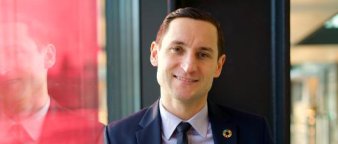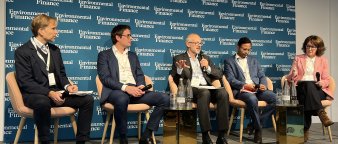Projecting scenarios of the future we want
In its new report, the IEA uses scenario analysis to show different versions of the future. In scenarios, we can see the modelled how various actions that can be taken now, could likely affect the path of global progress towards future targets, such as temperature rise, access to modern energy and participation in economic value creation.
The IEA outlines three scenarios in the new report:
🎢 Stated Policies (STEPS): Trajectory given the current policies
🌳 Announced Pledges (APS): All nations' aspirational climate and energy targets are met on time
🎯 Net Zero Emissions by 2050 (NZE): The global average temperature is limited to 1.5 °C and universal energy access is achieved by 2030
Of these three scenarios, the world wants the NZE scenario to happen, as scientists from the Intergovernmental Panel on Climate Change (IPCC) have urged in climate science reports for decades.
Major improvements in policies have already shifted the curve of the STEPS scenario to more positive outlooks, with the US Inflation Reduction Act in particular contributing to rise investments in clean energy to 2 trillion USD per year by 2030, which is 50 percent higher than today. China, EU, Japan, India and Korea have also amplified investments in the green transition a response to both meet climate commitments, health concerns and ensure energy security following Russia's warfare and shortage in supply linked to Covid-19 bottlenecks.
New climate pledges by India and Indonesia have helped steepen the curve of emissions reductions in the APS scenario, underscoring the importance of nations' commitments. Also, for the first time, the IEA includes sectoral commitments for specific industries and company targets, which is included in the APS scenario. The current temperature rise of the APS scenario is therefore improved to 1.7 °C in 2100.
Facing realities of the likely future
The UN Climate Change Conference is being held in Egypt in November. Countries gather to take action towards achieving the climate targets as agreed in the Paris Agreement. In what can be perceived as an increasingly polarized global society, glimmers of hope remain. As was said by the German professor of climate modelling Veronika Eyring during the opening ceremony of COP27, no nation, firm or individual can solve the climate crisis alone but global collaboration can help a systemic change while "creating new economic opportunities for zero carbon technologies" (2).
Current policies in the STEPS scenario project a temperature rise of 2.5°C, which is perhaps the most likely of the three. Not great by any means, considering the target of well below 2°C, but still decent considering that we were on a 6°C degree trajectory only a few years back.
Sometimes, when you bring the collective genius of humankind together, creative thinking about solutions can enable spectacular action. Although the initial media headlines about the COP27 event focused on the "see and be seen" personalities - the heads of state – the context of the event is dominated by an underlying seriousness felt by many people around the world. That sense of urgency is fuelled by multiple crises that many perceive as tangible experiences with recent impacts of climate change, such as devastating floods in Pakistan and Nigeria, droughts and shrinking glaciers around Europe, wildfires in North America, and worldwide damage from storms intensified by rising sea levels.
Investment Implications
In the World Energy Outlook, the IEA outlines several key actions that must happen, if we are to secure a future energy system that is more secure, sustainable and affordable:
📈 Increase investments in clean electricity, electrification, solar energy, wind energy and electric vehicles
🔋 Expand supply chains for key technologies like batteries, solar PV and electrolysers
🏡 Scale up energy efficiency, clean fuels, LED lighting, heating, ventilation, air conditioning, building design and insulation
The need to channel investments towards renewables, energy storage and energy efficiency is hardly surprising. At team Solutions, we call such investments "solution themes", to indicate that we need to accelerate investments in these themes to solve the UN Sustainable Development Goals. Our team invests in companies that have products or services that link to the four solution themes − "Renewable Energy", "Smart Cities", "Circular Economy" and "Equal Opportunities" − in the form of listed equities with a global mandate. The connected sub-themes cover all the mentioned technologies.
It's encouraging to see that the climate commitments of our portfolio companies help shift the trajectories of IEA's scenarios. Although we regard climate targets as highly desirable, actual capital allocation for climate action is even better. "Well done is better than well said", to quote the brilliant hurdle race coach Leif Olav Alnes. We gratefully adapt the phrase to count for corporate governance too. An important passage in the report highlights the role of investors as accelerators in the energy transition:
"Governments have to take the lead in ensuring secure energy transitions, but they can be significantly assisted by well‐functioning markets and market mechanisms that reflect the costs of pollution, by bringing in private capital and allocating it efficiently."
World Energy Outlook 2022
IEA
A clean, reliable, and fair energy system is both wanted and needed to regain balance in turbulent times. Financial flows hold the power to make things happen, not unlike the physical definition of energy. Therefore, well-directed financial flows may help accelerate the scenarios that lead to a desired future.
Sources:
(1) IEA (2022), World Energy Outlook 2022, IEA, Paris https://www.iea.org/reports/world-energy-outlook-2022, License: CC BY 4.0 (report); CC BY NC SA 4.0 (Annex A)
(2) Opening Ceremony of COP27, YouTube, time 1:29:56, available at https://youtu.be/abWWzAhHW40?t=5396
(3) IEA (2022), World Energy Outlook 2022, IEA, Paris, page 228, https://www.iea.org/reports/world-energy-outlook-2022, License: CC BY 4.0 (report); CC BY NC SA 4.0 (Annex A)







